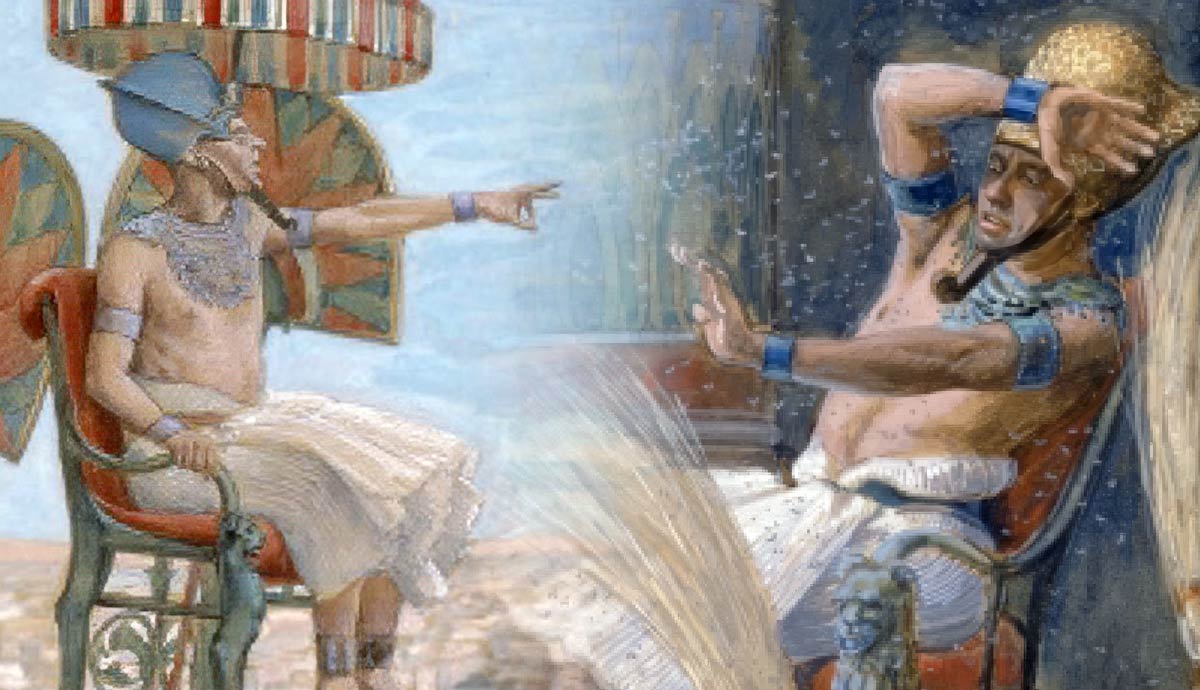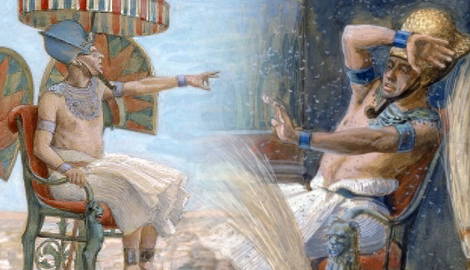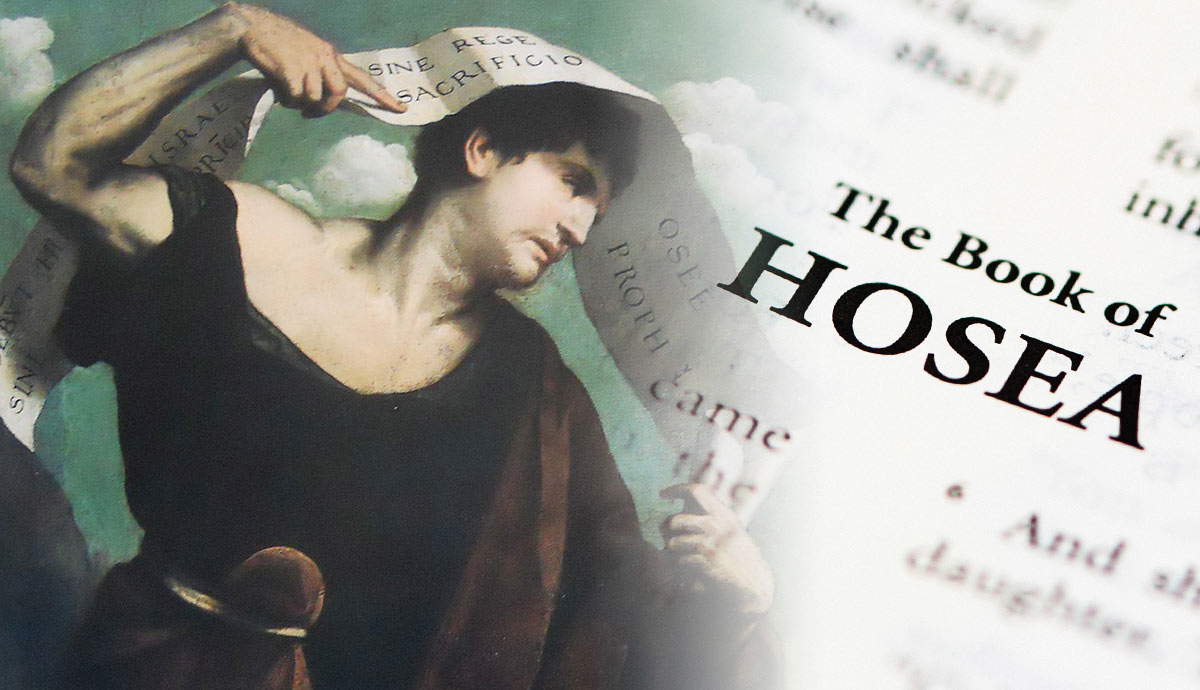
According to the Bible, Egypt had enslaved God’s chosen people for over 400 years. When God ordered Moses to petition the pharaoh for the release of the Hebrews, he warned the prophet about the difficulty of the task, “But I know that the King of Egypt will not let you go unless a mighty hand compels him. So I will stretch out my hand and strike the Egyptians with all the wonders I will perform among them. After that, he will let you go” (Exodus 3:19). The ten plagues of Egypt were intended to force the pharaoh to release the Israelite slaves and humiliate Egypt’s many gods.
The Story of Moses

The story of Moses is well-known. When the pharaoh of Egypt ordered all Hebrew baby boys to be killed, Moses’s mother placed him in a papyrus basket that floated down the Nile River to the place where the pharaoh’s daughter was bathing. She found him and adopted him. And so, Moses, an Israelite, was raised in Egypt as a prince. He had to flee the country when he killed an Egyptian overseer for beating a Hebrew slave. 40 years later, the Lord ordered him to return, saying, “Go back to Egypt. The men who wanted to kill you are dead now” (Exodus 4:19).
However, the intent of the subsequent plagues went beyond forcing the manumission of the slaves. They represented a polemic against the many Egyptian deities that the people worshiped. They were meant to show God’s superiority. In all of those centuries of slavery, many had lost faith in God and his ability to wrest them out of the hands of the Egyptians. In fact, some of them had abandoned Yahweh (the Hebrew name for God) and engaged in the worship of Egyptian gods. The plagues were to gain their attention as well as that of the pharaoh.
Who Was the Pharaoh?

The Bible does not name the pharaoh whom Moses and his brother, Aaron, confronted. Scholars suggest that, from a theological point of view, his identity is purposely omitted to indicate just how unimportant he was. He did not even deserve to be named. Down through the years, historians have claimed that he could be any one of a dozen Egyptian kings, including Pepi I, Necho II, Neferhotep I, Dedumose II, Merenre Nemtyemsaf II, Hatshepsut, Thutmose II, Ramses II, and Amenhotep II, for a variety of reasons.
For example, when Egyptologist Gaston Maspero unwrapped the mummy of Thutmose II in 1886, he discovered that the entire body was covered in scars and scabs, which suggested that the pharaoh might have been covered in boils such as those endured in the sixth plague.
Hollywood’s Cecil B. DeMille named the Pharaoh Ramses II (also spelled Rameses) in the classic film, The Ten Commandments, made in 1956. Many scholars have suggested that he was indeed that member of the Ramesside Dynasty, ruling at the time that Moses and Aaron made their plea for the release of the Israelites. They point to Exodus 1:11, which states that the slaves were put to work building the cities of Pitham and Rameses, the latter of which is usually linked with Ramses II.

However, a good number of historians and archaeologists insist the date for Ramses in the 13th century BCE is two centuries off the mark for the exodus of the Israelites. They use 1 Kings 6:1 to fix it in the 15th century when Amenhotep II reigned. This passage states that, “in the four hundred and eightieth year after the Israelites came out of Egypt, in the fourth year of Solomon’s reign over Israel, in the month of Ziv, the second month, (Solomon) began to build the temple of the LORD.” This temple was built sometime in the early to mid-10th century. Counting backwards, scholars place the exodus in the mid-15th century at a time when Amenhotep II was the pharaoh.
Amenhotep II was a nasty individual, noted for his cruelty. One record describes him ordering his enemies to be nailed to the city walls, but only after their hands had been cut off. It is not hard to picture him as the arrogant, obstinate, and infamous pharaoh described in the Book of Exodus.
Turning a Staff Into a Snake

At their initial meeting, Moses and his brother, Aaron, warned the pharaoh about the negative consequences should he refuse to let the Israelites go. Pharaoh dismissed them and their warnings, saying, “Who is the Lord that I should obey his voice to let Israel go? I know not the Lord; neither will I let Israel go” (Exodus 5:2).
The brothers’ warning was not merely verbal. They also demonstrated to the pharaoh just how powerful their Lord, Yahweh, was when Aaron threw down his staff and it turned into a snake. Snakes represented power to the Egyptians, and the pharaoh’s headdress looked like a cobra curling around his head. To turn a rod into a serpent was a direct challenge to the strength of the Egyptian nation, the pharaoh, and the country’s many gods.
The pharaoh’s magicians performed a trick of their own, throwing down rods that turned into serpents as well. But Aaron’s snake turned and devoured those created by the magicians, thereby illustrating that his God’s power was greater than that of the Egyptian sorcerers and their idols.
The incident offered a preview of what was to come, as it indicated that the Israelite God was in charge of creation and could manipulate it at will, as the upcoming plagues would further demonstrate. Ultimately, the event with the snakes showed the impotence of the Egyptians and their deities, just as the plagues would.
Overview of the Plagues

| Plague | Where it’s told (Exodus) | Note |
| 1. Turn Water into Blood | 7:14‑24 | The Nile and other waters turn to blood; fish die, and water becomes undrinkable. |
| 2. Frogs | 7:25‑8:11 | Frogs swarm into houses, beds, ovens—everywhere. |
| 3. Lice / Gnats | 8:12‑15 | Dust becomes tiny insects that torment people and animals. |
| 4. Swarms of Flies | 8:16‑28 | Dense clouds of biting flies (or possibly scarab beetles). |
| 5. Pestilence on Livestock | 9:1‑7 | A deadly disease kills horses, donkeys, camels, cattle, sheep, goats. |
| 6. Boils | 9:8‑12 | Painful boils break out on Egyptians and their animals. |
| 7. Hail (with Fire) | 9:13‑35 | A violent hailstorm, with lightning (“fire”), shatters crops and trees. |
| 8. Locusts | 10:1‑20 | Locusts devour what hail left, stripping the land bare. |
| 9. Three Days of Darkness | 10:21‑29 | Thick darkness so heavy “one can feel it,” yet Israel’s dwellings have light. |
| 10. Death of the Firstborn | 11:1‑12:30 | At midnight every Egyptian firstborn—human and livestock—dies; the Passover begins Israel’s escape. |
Most scholars divide the first nine plagues into groups of three according to their severity. The initial three—turning the Nile to blood, a proliferation of frogs, and the plague of lice—are considered unpleasant and annoying, but not damaging. The next three—the plague of flies, the killing of the livestock, and the affliction of boils—were far more severe and destructive. Plagues seven through nine—hail and thunderstorms, locusts, and total darkness—were even more devastating. Of course, the tenth and final plague, the killing of the firstborn son of all Egyptian families, was the most dreadful of all. So we see a progression from situations that were discomforting to those that were distressing and, finally, to those that elicited downright despair.
Plague #1: Turning the Nile River Into Blood (Ex. 7:14-25)

Without the Nile, Egypt would have been uninhabitable. If it did not overflow and deposit silt on the land regularly, the people would have nowhere to grow the crops necessary for their survival. Therefore, the Egyptians revered the river and worshiped it, as their hymn to the Nile demonstrated.
“Hail to thee, Oh Nile, that issues from the earth and comes to keep Egypt alive.”
The people associated a number of gods with the river. Hapi, an androgynous deity, was both the goddess of fertility and the god of the Nile, and, as such, was expected to keep it flowing properly. However, after Aaron lifted his staff and the water changed to blood, Hapi could not change the blood back to water. And while the people considered the river to be the blood of the god, Osiris, they probably had never imagined that it would, at one point, be flowing with real blood, the kind of blood that coursed through their bodies and spilled out when their skin was broken.
This plague, of course, would have negatively affected the Israelites as well as the Egyptians, as they depended on the Nile for life themselves. The river remained useless to the people for seven days. The fish in it died and stank. Then Aaron raised his staff, and the blood returned to water. Moses petitioned the pharaoh to let his people go, but the pharaoh refused.
Plague #2: An Inundation of Frogs (Ex. 8:1-15)

On the surface, a surplus of frogs does not sound that horrendous. But it was the sheer numbers of them and the fact that they were everywhere—in their food supplies and cooking pots, in beds and cradles with babies, wherever they stepped inside or out.
According to the Egyptians, frogs had divine power. Their god, Heqet (also spelled Heket or Heqat), had the head of a frog. They believed that she breathed life into the bodies of everything that her husband, Khnum, created. Therefore, they could never bring themselves to kill a frog.
Interestingly, the pharaoh’s magicians were able to conjure up a few frogs of their own. But the one thing they could not do was get rid of them. The frogs died, and there were piles of them everywhere, causing a horrible stink throughout the nation. The Israelites had to deal with them as well.
Moses told Pharaoh to name the time that he would like the frogs removed. The king supplied it, and the frogs were gone at the appointed hour. In this manner, the God of Israel showed up Heqet, who had been unable to do anything about the matter. However, in spite of this, the pharaoh still refused to let the Israelites go.
Plague #3: Of Lice and Men (Ex. 8:16-19)

Some scholars have suggested that the Hebrew word should be translated as “gnats” or even “mosquitoes.” Whatever the insects were, they swarmed thickly everywhere, and they bit and drew blood to the point that it must have driven the people crazy. The Egyptian magicians could not produce any of their own, which is probably just as well because they certainly did not need more of the critters. They called the plague the result of “the finger of God,” a phrase used elsewhere in the Bible (Exodus 31:18; Deuteronomy 9:10; Ps. 8:3; Luke 11:20) referring to the power of God intervening in the lives of people.
Once again, God showed up as an Egyptian deity, in this case, Geb (also called Seb), the earth god, who was powerless to do anything. And yet, the pharaoh still did not give in.
Plague #4: Flies, Flies, Flies, Everywhere and All the Time (Ex. 8:20-22)

For the first time, the Israelites were not affected by a plague. Where they lived in the land of Goshen was a fly-free zone. Pharaoh weakened a bit and agreed to let the Israelites worship their God, but they had to do it in Egypt, not in the desert as Moses requested. Moses refused the offer, at which point the pharaoh made another concession. He said that the Israelites could go out into the desert to worship Yahweh and, then, surprisingly, he asked Moses to pray for him. Of course, after the flies had been removed, he changed his mind, and the Israelites stayed where they were.
Uatchit, the fly goddess of Egypt, said to guard the Nile delta, was powerless throughout this ordeal, as was Kephri, the beetle-headed god of the morning sun and rebirth. Kephri was thought to bring renewal and to run the sun across the sky the way a scarab rolled up dung. But he could not get rid of the flies.
Plague #5: Death of Livestock (Ex. 9:1-7)

Moses warned Pharaoh of what was to come. It did not change the king’s mind. While the death of camels, sheep, goats, etc. would have been significant, it was the loss of their cattle that was particularly devastating. Wealth was measured in terms of how many cattle a person owned. The bull represented the god Apis. The cow represented the goddess Hathor, who was the goddess of love, beauty, and joy. She was depicted in the form of a woman with the head or the horns of a cow. Neither deity could save a single animal. As with the other plagues, the Egyptian gods were useless and could not end the destruction. And still the pharaoh remained obstinate.
Plague #6: Way Beyond the “Boiling” Point (Ex. 9:8-12)

Moses took a handful of ashes from a furnace (probably one that Israelite slaves used to make bricks for their masters) and threw it in the air. As they blew over Egypt, people were struck with boils all over their bodies. Egyptians were terrified of diseases and pestilence, which could wipe out a population quickly, so this plague would really have frightened them. They worshiped Sekhmet, the lion-headed goddess of healing, expecting her to keep them from developing illnesses and to heal them should they be unfortunate and get sick.
Not only were the pharaoh’s magicians incapable of duplicating the Lord’s feat or eradicating the boils, they themselves were struck down and were physically unable to appear before Moses. The Egyptian gods had been bested once again. But still Pharaoh did not relent.
Plague #7: Thunder, Lightning, and Hail Aplenty (Ex. 9:13-35)

The Egyptians must have thought that the world was ending as God inflicted the worst storm in Egypt’s history upon them (Exodus 9:18). It came with Moses’s warning that, unless the pharaoh released the Israelites as he had been asked to do numerous times, God would “send the full force of his plagues” against him, his officials, and his people so that they might “know there is no one like (God) on earth” (Exodus 9:14).
Verse 16 of chapter 9 tells us that God raised up Pharaoh for the purpose of hardening his heart, giving God the occasion to manifest his power to all. Earlier in Exodus, it says that Pharaoh hardened his own heart, but God further hardened it here, in essence, confirming the Egyptian king’s choice to defy the Lord.
Nut, the sky goddess, Isis and Seth, both agricultural deities, and Shu, the god of the atmosphere, were all shown up as they could do nothing to stop the plague or protect the people, their homes, and their crops.
Plague #8: Day of the Locusts (Ex. 10:1-20)

While the thunderstorm and hail would have destroyed the ripe flax and barley crops, the wheat and spelt would have been fine as they matured a little later (Exodus 9:31). However, they didn’t last long as the locusts swept in and wiped them out.
This time, Moses told the pharaoh in advance that the insects were coming. The pharaoh’s officials pleaded with him to let the Israelites go. They had had enough and could not take any more. Pharaoh responded by telling Moses that he would let the men go, but not the women. This, of course, was not acceptable to Moses. It was all or nothing.
Once again, Nut, the goddess of the sky, was powerless to control or end the storm, and, surprisingly, when the plague hit, Pharaoh actually broke down and confessed that he had sinned against the Israelites and against God. However, it was no surprise that locusts stopped; he returned to his old self and refused to let the Hebrews go.
Plague #9: Wait Until Dark (Ex. 10:21-19)

Imagine a darkness so intense that you literally cannot see your hand in front of your face. It was impossible to go out, and both the Egyptians and the Israelites remained in their homes for the duration. The Israelites, however, did have light in their dwellings. The Egyptians had none at all. To them, darkness meant death, so the psychological impact on the people would have been huge. And it had come without any warning at all, so no one was prepared for it.
The sun was the most-worshiped god in Egypt, which perhaps accounts for the many sun gods that they had. There was Re (also spelled Ra), who was responsible for providing sunlight for the Egyptian crops, as well as Amon-Ra, Aten, Atum, and Horus—all of whom were equally impotent in the face of this darkness. Thoth, the moon god, also failed the people. The plague also embarrassed Nut, the sky goddess.
Finally, after three days, the darkness was lifted. Pharaoh said that the people were free to leave, but that their cattle must stay. Moses rejected this offer. But the king had had enough. He told Moses to leave his presence and warned him that, if he returned, he would have Moses put to death. Moses left, but not before telling Pharaoh that the worst plague of all was coming.
Plague #10: The Death of all Firstborn Sons (Ex. 11:1‑12:30)

Moses came full circle with this one. When he was born, the pharaoh in power at the time had decreed his death along with that of all boys born to Hebrew parents. Now God, through Moses, issued the decree that all firstborn sons of the Egyptians were to be killed, including that of the pharaoh. Pharaoh himself was considered a god, the son of Re, and this plague was a direct attack on him personally and the power he pretended to wield.
The Israelites were told to slaughter unblemished male lambs and mark the doorways of their homes at the top and along the sides with the blood of the animals. This would tell “the destroyer” to leave that household alone because only Egyptians were meant to lose their children (Exodus 12:23). However, if any Israelite did not follow these instructions, their firstborn would be taken as well.
This, of course, is what we now refer to as the Passover, something celebrated by Jewish people from that time forward. Today, Christians join in its celebration as well because they believe that Jesus was the unblemished (sin-free) lamb that God chose to die on their behalf and atone for their sins (1 Peter 1:19). They see the first Passover as a foreshadowing of what was to come with the death and resurrection of Jesus Christ and see themselves “passed over” by the destroyer as acceptance of Christ in faith assures them of eternal life.
Conclusion: The Parting of the Red Sea

It is no surprise that Pharaoh changed his mind yet again. The story is well-known. God parted the Red Sea so that his people could get safely to the other side. When the Egyptians in their chariots caught up, they started across the seabed, but the walls of water collapsed, drowning all of them. While the Hebrews were no longer slaves, they would spend 40 years in the wilderness before entering Canaan, the land God had promised would someday be theirs.









